
真夏に、洋風の家を取り壊しています。鉄骨構造と中庭が見えるようになりました。
In the heat of summer, the young workers dismantled the 1970s house seen in the last post. The demolition reveals the steel structure and large internal courtyard.

とてもフレンドリーなガテン系の青年は靴を指差して「ジャパニーズ足袋」と言いました。これから、中野にある住居の取り壊しのシリーズをはじめます。取り壊しの時に、住居の中が見えます。真夏なのに、若いガテン系さんは一所懸命に働きます。
On my way to the station, I first notice a large truck parked in front of an old house. A minute further down the small street, this orange-haired youth greets me, and points at his shoes, saying “these are Japanese tabi.” Tabi are the mitten-like shoes worn by Japanese construction workers and farmers. He very willingly posed for his portrait, with the demolition site in the background.
This is the start of a series on the demolition of two adjacent Nakano houses. One was, at one time, an elegant and understated Showa-era home, with clean lines and a few blue ceramic roof tiles as decoration. It’s neighbor is a more international-style home from perhaps the 1970s. The demolition took place during the heat of summer in August.
Home demolitions give you a rare peak inside the homes of strangers, allowing you to see interior courtyards, old kitchens, and other “private spaces.” The demolition requires weeks of dismantling and trash sorting. There’s some machinery for the heavy lifting, but much of the energy for these small projects comes from youth.

夏、エアコンの上はベランダの庭で一番暑いところです。今そこに多肉サボテンを置きました。この陶芸の植木鉢は手仕事屋久家で作りました。
The balcony summer hotspot is the air conditioner, almost always on and blowing hot air. This summer, I’m enjoying succulents which seem fine on top, but probably not in front, of the a/c. They have fun colors, shapes, and even textures. The ceramics were made at Kuge Crafts.

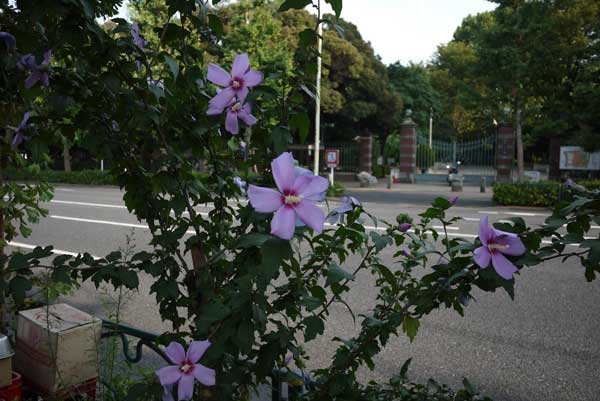
8月はあまり花が咲きません。多分、暑すぎるからです。けれども、東京の歩道で、ムクゲは育ちやすいです。明るい色と江戸文化との関係に興味があります。
August has more foliage than flowers, and it seems that few can bear the unrelenting heat. That’s what’s so wonderful about “Mukuge” (ムクゲ) a Japanese hibiscus that grows easily on Tokyo city sidewalks. I like the wild colors that make the city more spectacular, and Mukuge forms part of the Aoi (アオイ)family of flowers associated with the Edo shogunate.
Photo of Omeikaido Dori sidewalk, across from Sanshinomori Park in Higashi Koenji 蚕糸の森 公園、東高円寺。A small sign says that it was planted in March, 2010 with support from KDDI.

Today’s mild typhoon is a welcome relief after more than six weeks of record-breaking heat and absolutely no rain in central Tokyo. I was getting worried about the street trees and all the “independent” plant life that survives in Tokyo without human care.
For some reason, the bitter melon I planted by seed in April only recently started climbing like crazy. Here’s an image of a baby bitter melon in the rain, with its flower still attached. Hope to eat some in a few weeks.
Did you know that Japanese typhoons are not given names like in the United States? Today’s typhoon is simply 10W.
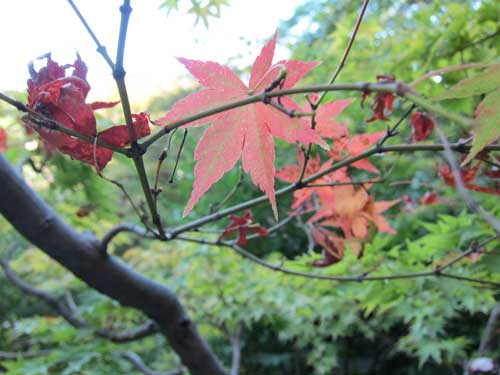
It’s been Tokyo’s hottest summer on record. While officially summer is over, it’s still 35 celsius during the day and not much cooler at night. That’s why I was so surprised to see this red maple leaf at the Nezu Museum garden last Thursday. This sign of fall seems a cruel joke.
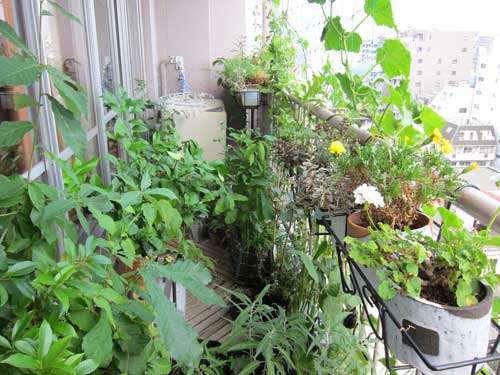
I took this photo a month ago, and our balcony garden is now even more lush. It’s amazing how much incredible heat and daily watering can increase bio-mass!

It’s amazing what you can fit in a sunny narrow space. I have six mini-watermelons ripening on the railing and green net, three Saipan lemons, two types of morning glory, the 5bai midori satoyama boxes bushing out, cucumbers still flowering and creating fast food, and some random flowers including mini-sunflowers, abutilon, and Suntory hybrids ミリオンベル (million bell) and アズーロコンパクト. Plus there’s basil, parsley, and thyme, all of which I put into my bolognese pasta lunch today.
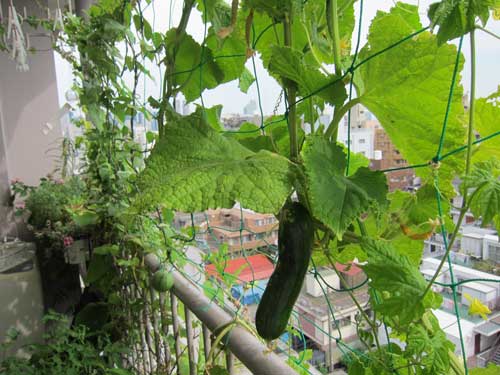
The floor area is full with just enough room to walk through for watering. The vertical space is about half full with the net and some additional twine. I like how the old washing machine is nearly hidden by plants.
Some failures included corn, with tiny ears that formed and then turned brown. The rose which was so outrageously pumped up when purchased has hardly bloomed since. The incredible heat this month killed my first bonsai, a Japanese maple (もみじ) in a tiny pot.
Some surprises included the late growing bitter melon (ゴーヤー) now shooting up. I planted last year’s seed in April, and it hardly grew until about three weeks ago. Now it’s two meters tall, and perhaps will produce a few vegetables before typhoon season. Bitter melon tastes great with ground pork!
My friend Matthew, who now works at Sinajina, pruned my pine bonsai. Apparently now is the time to start thinking about shaping it and preparing it to look its most beautiful for the new year. I wonder how to keep my tiny garden green during winter.

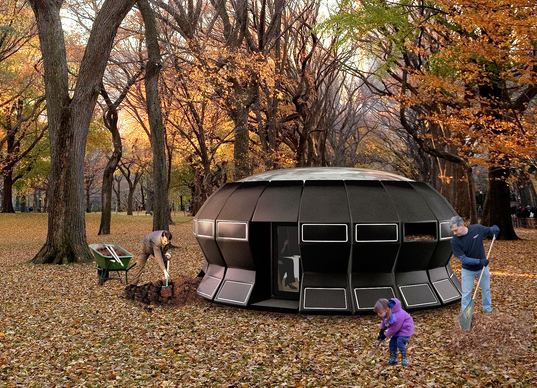
Architect extraordinaire Alastair Townsend at Bakoko designed this amazing tea house heated with compost, named Comploo. What an amazing idea to integrate habitable space with the heat from compost. Functional, beautiful, and inspiring.

Inspired by the Suginami Ward Office’s giant green curtain, we have started a green curtain for our south-facing balcony using bitter melon and morning glory. Above you can see the first vegetable taking shape. Below a wine-colored morning glory; other colors include white, blue and white, pink and white, and “crystal blue” from Okinawa.
With twine, we have created a simple structure connecting the railing with the laundry support attached to the balcony ceiling. It is amazing how fast the vines grow in the Tokyo heat and humidity.
